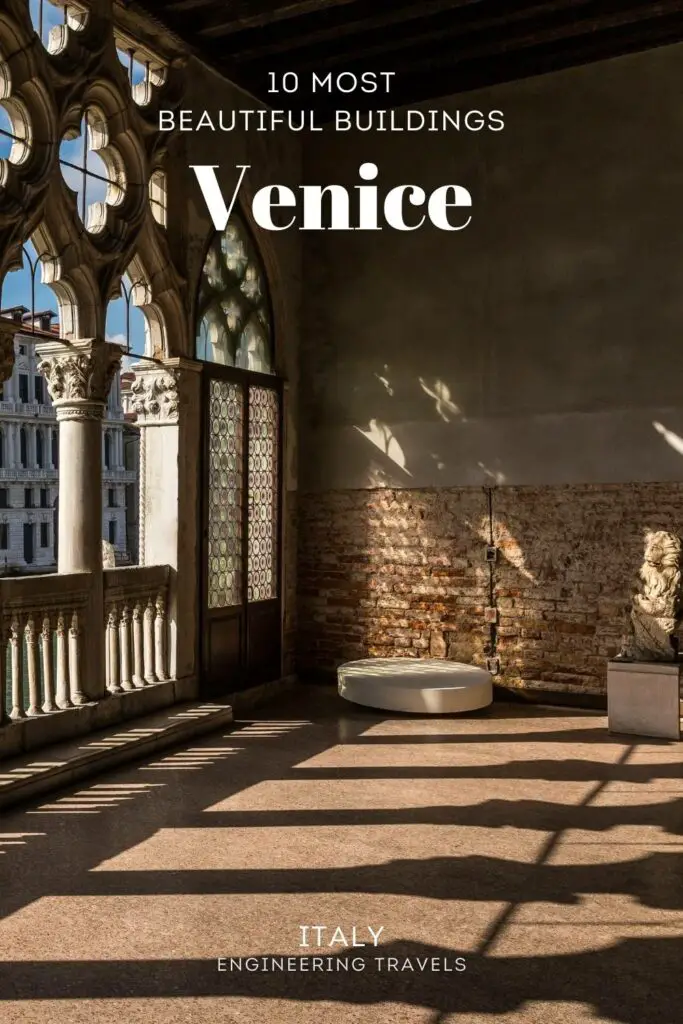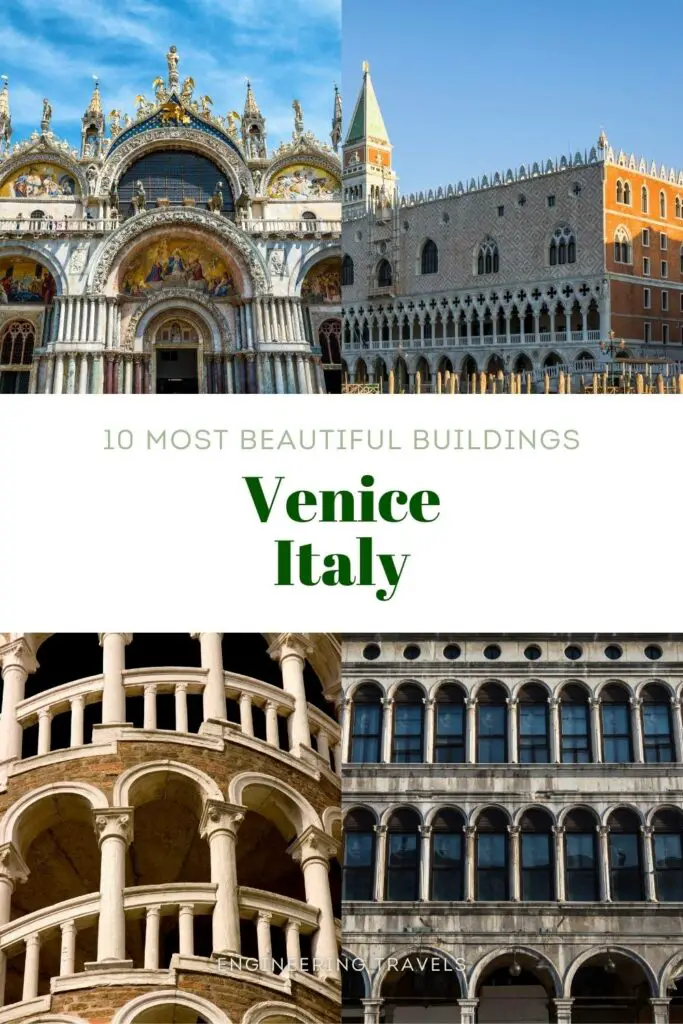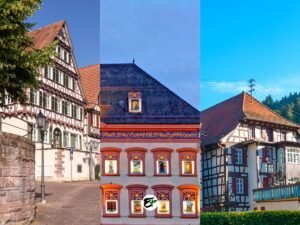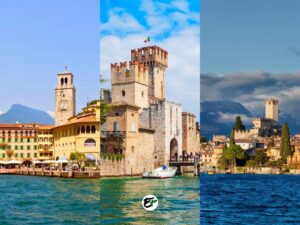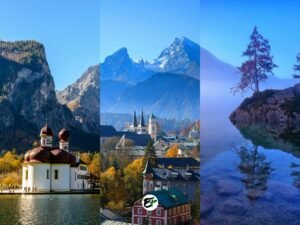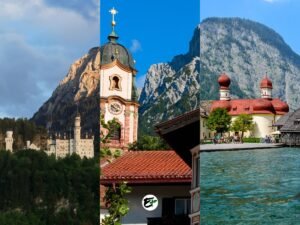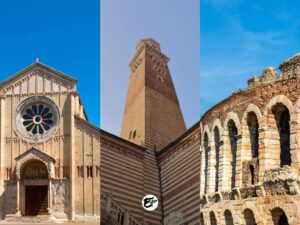10 Most Beautiful Buildings in Venice + Google Maps Location
Even with issues like overcrowding, skyrocketing travel expenses, and flooding, one cannot simply ignore the beautiful city of Venice when planning the ultimate trip to Northern Italy.
Venice’s uniqueness just makes it an irresistible destination. Like you can ask this question — in which city can you wander without setting foot on the ground, instead navigating its quaint, romantic, history-filled canals by gondola? There’s nowhere else but Venice!
The thing is, the gondola ride could definitely be a once-in-a-lifetime experience, particularly if you are a traveler like me who is from a faraway country with a totally different culture. While the gondola ride alone could be a reason to visit Venice, amazingly, it’s not the only enticing experience that Venice presents.
Venice is home to a wealth of stunning architectural landmarks that are sure to captivate wanderers like me. From awe-inspiring churches to magnificent palaces and theaters, Venice presents a cityscape that is truly a visual spectacle.
This post contains affiliate links. I may receive a tiny commission at no additional cost to you.

Use the table of contents to skip to topics.
Exploring Venice, I felt sad thinking about how the city might sink because of the sea level rising from climate change.
The city has beautiful landmarks that are culturally and historically very important to humanity. It’s just sad to think they might be underwater in a few decades if we don’t take action now. Future generations also deserve to witness the splendor of this amazing city, especially given its unique architecture.
Venice’s architecture is a fusion of various styles, each narrating a tale of its rich history and diverse cultural influences. Gothic, Byzantine, Islamic, and Renaissance elements flourish in Venice. Traveling to Venice is an extraordinary experience — it’s like catching a glimpse of different cities from the old continent and blending the visual spectacle into one.
The Gothic style, with its pointed arches and ribbed vaults, originated in 14th-century Venice. The city’s older structures, like the iconic St. Mark’s Basilica, showcase the intricate mosaics and domes characteristic of Byzantine architecture.
As you wander through its narrow alleyways and grand piazzas, you’ll notice elements of Islamic architecture, a testament to Venice’s eastern trading partners. The architectural grandeur of the city reached its peak during the Renaissance, when the wealthy mercantile class commissioned magnificent works of architecture.
In this post, I’ll introduce you to the architectural marvels of Venice that held my gaze for minutes on end, leaving me in awe of their inherent beauty. Should you wish to embark on your own exploration of Venice, I’ve included a map at the end of this post. This map, complete with a layer indicating an efficient route, will guide you to the architectural gems I discovered.
Every building features a design that’s beautiful and unique, making it impossible to compare them directly or determine a ‘best’ one. So, I’ve decided to present them in alphabetical order for ease of reference.
1. Basilica Cattedrale Patriarcale di San Marco
We start our exploration of Venice’s stunning buildings with none other than the renowned Saint Mark’s Basilica, formally known as the Patriarchal Cathedral Basilica of Saint Mark.
This architectural marvel is located to the east of Saint Mark’s Square, which was the hub of political and religious activities during the reign of the Republic of Venice. The basilica was originally built in the 9th century but underwent several reconstructions. The design we can take in today is primarily from its third rebuilding, which was finished in 1094.

Briefly, here is what I can say about this church: Saint Mark’s Basilica is a masterpiece of Italo-Byzantine architecture, and every inch of this church is sure to leave you in awe. From its outside walls to its chapels, from its domes to its floor, every detail is a stunning piece of art. The basilica alone could be reason enough to make a trip to Venice!
Its architectural style, deeply rooted in the cultural context of Constantinople, is like a beautiful dance between East and West, where Roman grandeur meets Eastern opulence. The basilica’s design was influenced by the Church of the Twelve Apostles in Constantinople, which is a testament to the cultural exchange that occurred during this period.
The basilica itself is a marvel of geometry and symmetry, featuring a Greek cross inscribed in a rectangle, covered by five main domes. Each dome is like a celestial body, casting an ethereal glow that illuminates the intricate mosaics and carvings below.
Saint Mark’s Basilica has three facades – north, south, and west. The west side, facing Saint Mark’s Square, is particularly stunning. It’s so detailed that you can’t take it all in with just one look. This side of the basilica has five portals, each decorated with meaningful religious carvings.
Above each doorway are two arches filled with beautiful mosaics that tell stories from the Bible. The largest doorway and the windows above it are crowned by a golden image of a Winged Lion, the symbol of Venice and its patron saint, Saint Mark.
Step inside Saint Mark’s Basilica in Venice, and you’ll be greeted by a world of gold. Yes, you heard that right. The walls and ceiling of the basilica are adorned with golden mosaics. These mosaics cover a staggering 8000 square meters (or 86111 square feet) of the basilica’s interior, a feat that took over 800 years to complete.
Just think about the sheer amount of work that went into creating this masterpiece! The mosaics depict religious inscriptions and images of saints against a gleaming golden background, narrating the history of Christianity. It’s an awe-inspiring sight that can give anyone goosebumps, especially if you’re of the Catholic faith.
However, regardless of your beliefs, Saint Mark’s Basilica is a place that commands admiration. The splendor and the extraordinary human creativity embodied in this church are simply unparalleled. Take a look:
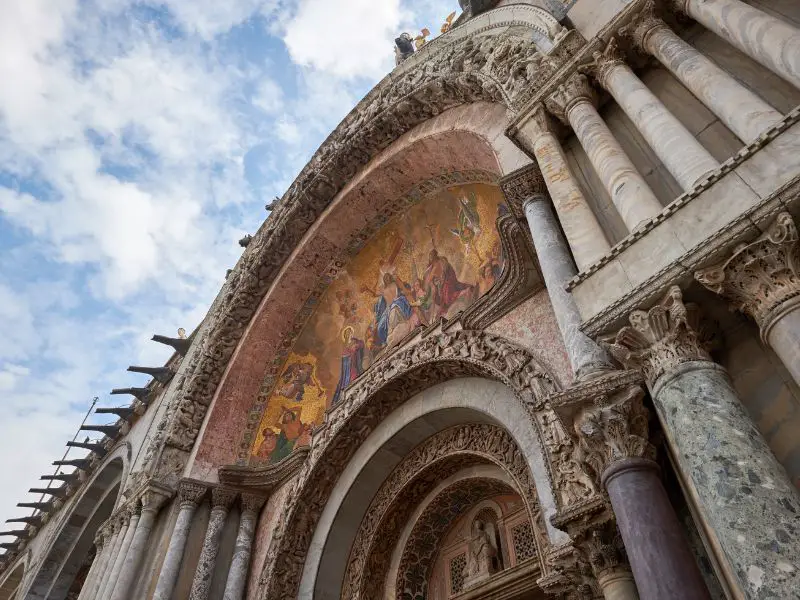
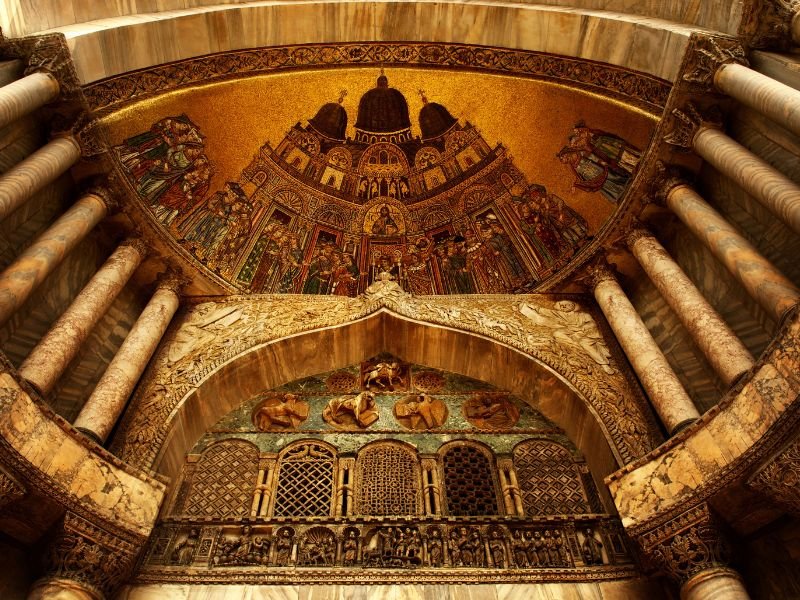
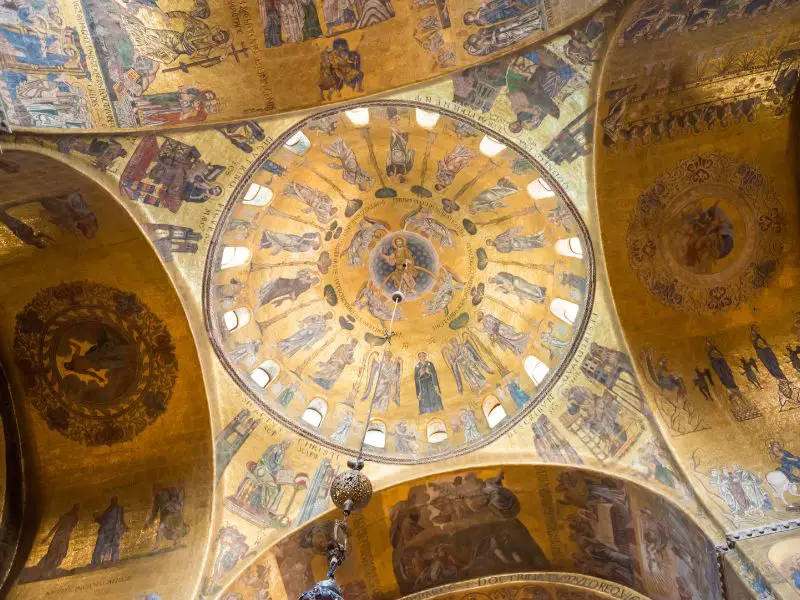
Saint Mark’s Basilica is an architectural wonder, monument steeped in history, and a pilgrimage site important to all believers.
Built back in 828, it was designed to be a sacred resting place for the relics of Saint Mark the Evangelist, which were smuggled into Venice by two daring merchants. This rich historical context adds an extra layer of intrigue to your visit.
One of the most magical moments at the Basilica is during the evening tour. As daylight fades and the Basilica lights up, the mosaics seem to spring to life, revealing details that are easy to miss during the day. During your visit, don’t forget to check out the view from the terraces. From there, you can enjoy a unique perspective of Venice and appreciate the Basilica’s architectural details from a different angle.
The Basilica is open from 09:30 am to 5:00 pm from Monday to Saturday, and from 2:00 pm to 4:00 pm on Sundays. The best time to visit is during the shoulder season — that’s April to May or September to November when the crowds are smaller.
As for tickets, they range between 3 EUR and 6 EUR. You can buy them online from the official webshop or other ticket platforms like GetYourGuide. If you’re planning to visit multiple attractions in Venice, consider getting the Venice Pass. It includes a visit to St Mark’s Basilica and lets you skip those long lines.
If you are interested to see more stunning religious landmarks in Europe, check out Sainte-Chapelle in Paris, Cathédrale Notre Dame de Strasbourg in Strasbourg, La Basilique Notre Dame de Fourvière in Lyon, Sistine Chapel in Rome, Cathedral of Santa Maria del Fiore in Florence, Frauenkirche and Lorenzkirche in Nuremberg, and Asamkirche in Munich.
2. Basilica di Santa Maria Della Salute
Moving forward in our journey through Venice, we come across a remarkable structure at the entrance of the Venice Grand Canal. It’s the Basilica di Santa Maria Della Salute, or as most folks like to call it, ‘Salute’.

The Basilica di Santa Maria Della Salute, built in the 17th century, stands as a symbol of gratitude to Our Lady of Health. This beautiful Baroque church was constructed following the Black Plague that swept across Europe, as a token of thanks for deliverance from the disease.
This is why you’ll find artworks inside the Salute referencing the Black Plague. The Basilica’s symbolic presence in the Venetian skyline has inspired many artists, including Canaletto, who painted the ‘Entrance to the Grand Canal’ featuring Venetians sailing in front of the Basilica.
While the Basilica di Santa Maria Della Salute might not be as detailed as the Basilica Cattedrale Patriarcale di San Marco on the outside, it’s brimming with Marian symbolism that’s fascinating to decipher.’
The grand dome of the church is designed to represent Mary’s crown, while the vast interior space symbolizes her womb. The octagonal design of the church, with its eight sides, is a nod to the eight points on Mary’s symbolic star.
Istrian stone and Marmorino are the primary materials used in the construction of the Basilica di Santa Maria Della Salute.
With the 125 sculptures representing different saints, evangelists, and prophets, it looks much more breathtaking. Inside, you’ll find stunning paintings by Titian and Tintoretto, including Tintoretto’s “Marriage at Cana”.
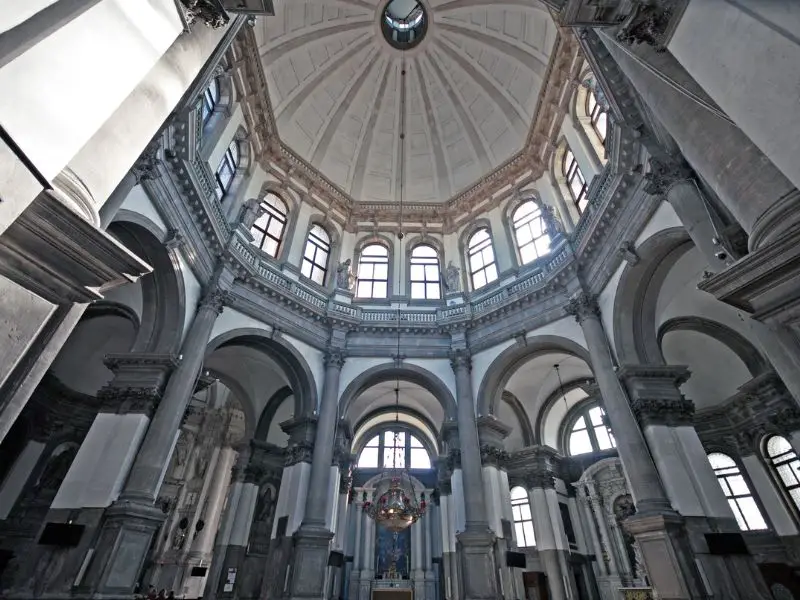
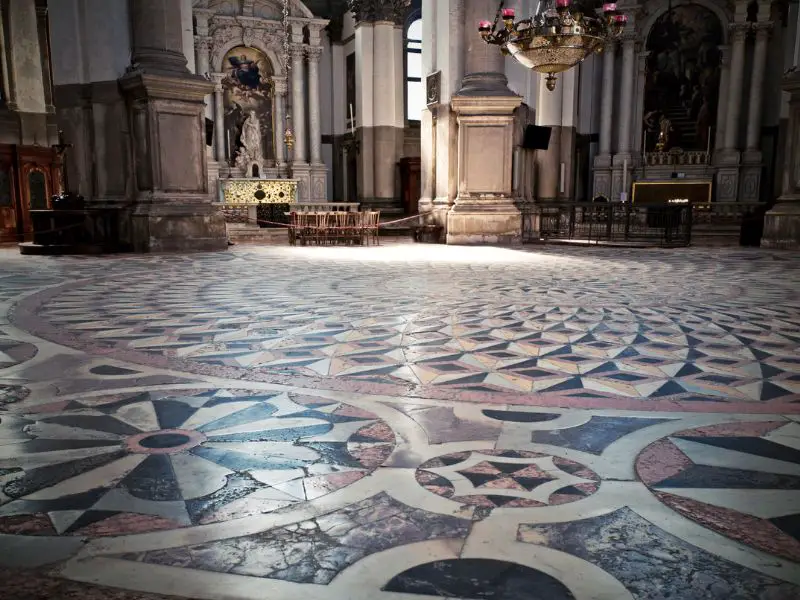

Now, if you’re planning to visit, here’s what you need to know. The Basilica is open every day from 9:30 am until noon and from 3:00 pm until 5:30 pm. You can enter the basilica for free! There’s a small charge if you want to visit the sacristy which houses more art.
One thing you absolutely can’t miss is the Festa della Madonna della Salute. It’s held every year on November 21st to celebrate the end of the plague. Imagine this – Venetians crossing an improvised bridge over the Grand Canal to reach the Salute Basilica. It’s a fascinating event to behold!
There are several spots in Venice where you can get a fantastic view of the Basilica di Santa Maria della Salute:
- The Terrace of St. Mark’s Basilica: This terrace runs along the west and south façade of the basilica and from here you get a wonderful view, not only of Basilica di Santa Maria della Salute, but also St. Mark’s Square, Torre dell’Orologio, the Doge’s Palace, and the Venetian lagoon.
- Onboard a Boat on the Grand Canal: One of the best views of Santa Maria della Salute is onboard a boat, sailing down the Grand Canal.
For updates and more information about Basilica di Santa Maria della Salute, please see its official website. You might also want to see the architecture tours in Venice here.
3. Ca’ d’Oro
Next up on our tour of Venice is the Ca’ d’Oro, also known as the Palazzo Santa Sofia, it is a palace from the 15th century.
Situated along Venice Grand Canal (it has its own station just a stone’s throw away from the Rialto bridge), this palace is like a time capsule, filled with artworks by Titian and Van Dyck, as well as more relics from the Renaissance.
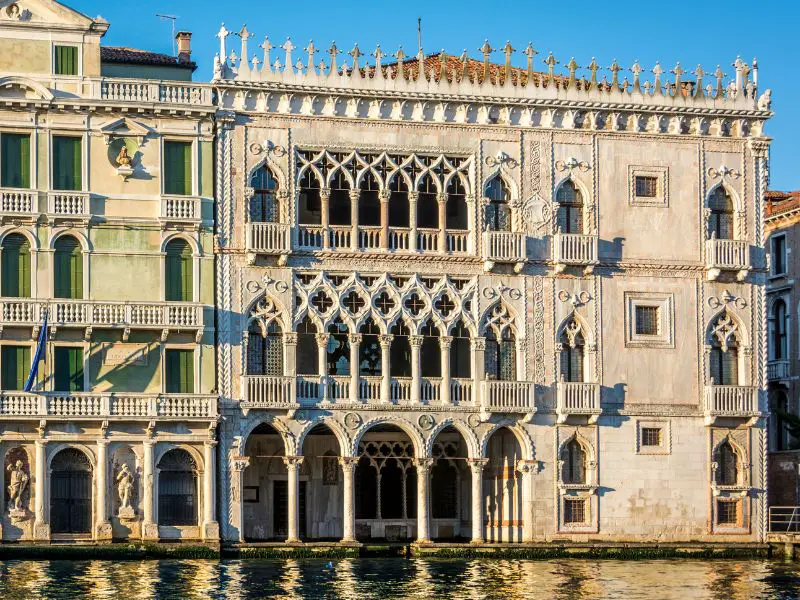
When you’re in Venice, you can’t miss the Ca’ d’Oro. It’s considered the finest example of Venetian Gothic architecture (a blend of Gothic, Moorish, and Byzantine architecture into a unique aesthetic) still standing. The facade is adorned with Bons’ floral Venetian Gothic style, much like the famous Doge’s Palace we talked about earlier.
But it’s not just for show — you can actually go inside! It’s now home to the Galleria Giorgio Franchetti, where you can see sculptures and paintings from the 15th to 17th centuries. One standout piece is the ‘Madonna and Child’ by Michele Giambono.
Ca’ d’Oro has three stories, which you can easily see by looking at its adorable facade. The base level of the building features a covered outdoor walkway with five arches. The second and third levels boast balconies, each supported by five pillars and topped with quatrefoil window designs.
The architectural harmony between the two balconies is truly impressive. The alignment of the arches and pillars, coupled with the quatrefoil windows above each pillar, creates a mesmerizing pattern. Additional details like the roof decorations, the rectangular frames around the windows, and the wavy edges contribute to the elegance of Ca’ d’Oro.
It’s a sight you can’t resist capturing as you sail down the Venice Grand Canal.
The interiors of Ca’ d’Oro are equally stunning. The floor patterns in the building’s portego, known as Cosmatesque, are incredibly photogenic; a characteristic of Medieval Italian architecture.

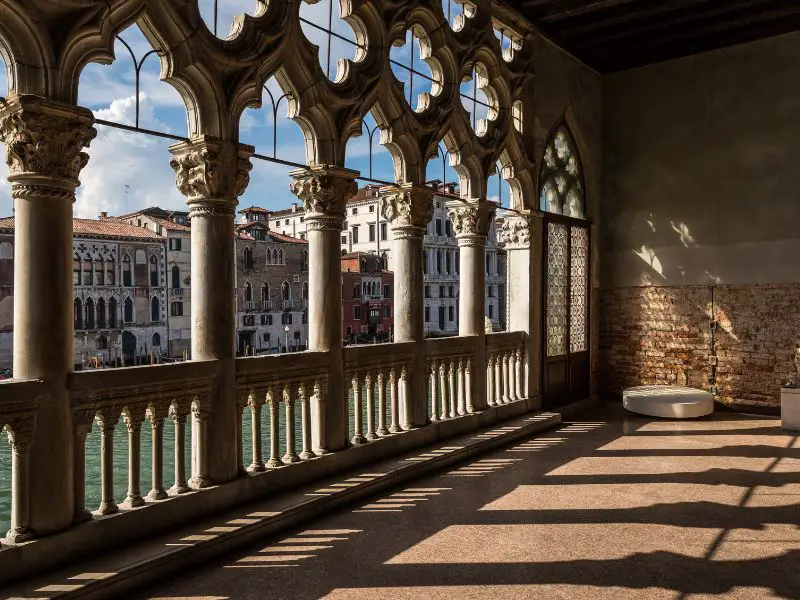

Indeed, when you’re there, don’t miss out on the Galleria Giorgio Franchetti inside the palace. This art museum houses an impressive collection of works from around the world, started by Baron Giorgio Franchetti at the end of the nineteenth century. If you’re planning a visit to the gallery, you can find the visiting information on its official webpage.
4. Ca’ Rezzonico
There’s another impressive structure in Venice that doubles as a museum. It’s known as Ca’ Rezzonico, a palace that showcases the Venetian rococo and baroque styles.
This public museum houses a collection of 18th-century Venetian art and is managed by the Fondazione Musei Civici di Venezia. Like the Ca’ d’Oro, the Ca’ Rezzonico is situated along the Venice Grand Canal, specifically in the Dorsoduro Sestiere district.
The splendor of Ca’ Rezzonico is a testament to the creative genius of Baldassare Longhena and Giorgio Massari, its architects. These two were among the most renowned architects of Baroque architecture in Venice during their era.
The construction of the building initially faced financial constraints, but it eventually emerged as a successful project. Today, its facade, adorned with white marble columns, sculptures, and bas reliefs, captivates visitors journeying along the Grand Canal.
The true wonder of Ca’ Rezzonico is found within its walls, where it houses some of the most remarkable 18th-century Venetian paintings for public viewing. This is where you’ll discover the masterpieces of renowned artists like Giambattista Tiepolo, Giandomenico, Canaletto, Rosalba Carriera, and others. The building spans four floors, but the first floor is particularly noteworthy.
Among the 11 rooms in Ca’ Rezzonico, three that are sure to leave you in awe are the Tiepolo’s Room, the Ballroom, and the Room of the Nuptial Allegory. Be ready to crane your necks, as the frescoes and paintings in these rooms are truly exceptional.
The ballroom, with its ceiling frescoes and two grand chandeliers, is particularly captivating to me. At the center of the ceiling is a fresco by Giovanni Battista Crosato, which depicts the chariot of Phoebus. Surrounding the chariot are representations of life on the four continents: Africa, America, Asia, and Europe.
If you want to learn more about the museum inside Ca’ Rezzonico, download the PDF file below from the official website of Fondazione Musei Civici di Venezia. Here you can find more history, the building, layout and collections, maps, and general information about Ca’ Rezzonico.
Explore Ca’ Rezzonico’s ballroom using the 360-image below:
Ca’ Rezzonico is open from 10:00am to 6:00pm from April 1st to October 31st, and from 10:00am to 5:00pm from November 1st to March 31st. However, it’s closed on Tuesdays, so you might want to plan your visit accordingly. Please do not forget to check for updates and announcements.
You can purchase tickets directly from the official website of Ca’ Rezzonico, or from other ticketing websites. There’s also a combined ticket called “The Museums of 18th Century Venice” which includes Ca’ Rezzonico, Palazzo Mocenigo, and Carlo Goldoni’s House. If you’re planning to visit multiple museums, this could be a great option!
For those interested in learning more about the exhibits, guided tours are available for adults. You can also rent an audio guide for a small additional fee or download an online audio tour.
5. Doge’s Palace
Saint Mark’s Square is home to Venice’s most iconic sights and architectural gems, including the Doge’s Palace, which stands alongside the Basilica of Saint Mark.
The Doge’s Palace, also called Palazzo Ducale or Duke’s Palace, served as the residence of the chief magistrate and leader of the Republic of Venice from 726 to 1797. For centuries, it was the city’s seat of power until it was transformed into a museum in 1923.
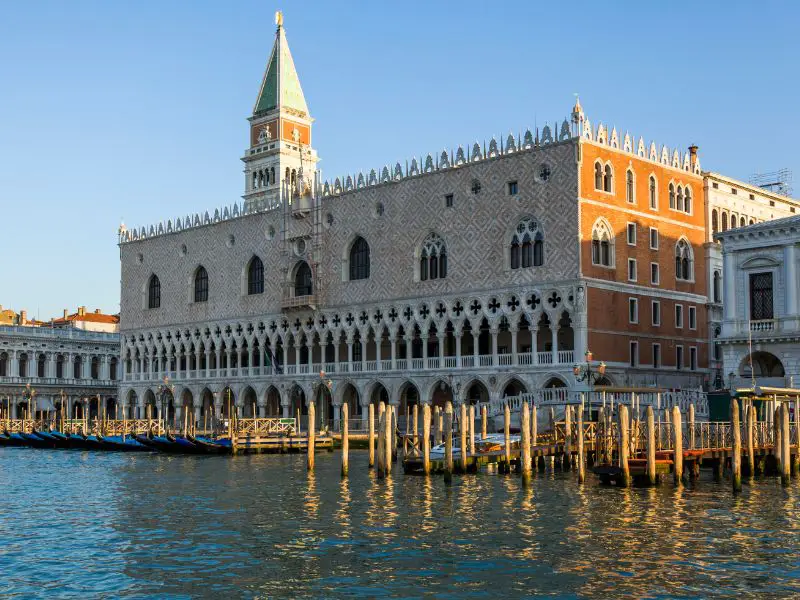
Get the skip-the-line entry passes/tours of Doge’s Palace here.
The Doge’s Palace, known as Palazzo Ducale in Italian, has been the heart of political power and home to the Doge, the ruler of Venice, since it was built in 1340. Over the centuries, it has seen numerous extensions, renovations, and demolitions to adapt to the changing needs of the city.
The palace has witnessed many historical events. It was here that Venice fell to Napoleon in 1797, marking the end of the Venetian Republic.
After Venice became part of Italy in 1866, the palace became state property. Throughout the centuries, many notable figures have been associated with the palace. Among them is Giacomo Casanova, a famous Italian adventurer who was imprisoned here in 1755.
Today, the palace serves as a museum and is one of 11 run by the Fondazione Musei Civici di Venezia. It’s a place where you can step back in time and immerse yourself in Venice’s rich history.
Architecturally, the Doge’s Palace is a masterpiece of Gothic architecture. Its unique Venetian Gothic style is evident both in its original design and its current state. The facade is adorned with decorative motifs, marble columns, and pointed arches.
Inside, you’ll find grand halls decorated with frescoes and artwork by renowned Venetian artists. You can see works by famous Venetian artists like Tintoretto, Veronese, Tiepolo, and Bellini. They are a remarkable collection of artworks that tell the story of the Venetian Republic.
One of the highlights inside the palace is the Giant’s Staircase, where you can see two statues of Poseidon and Mars, representing Venice’s trade and political power. Between them is the winged lion, the symbol of Venice’s patron saint, St. Mark.
The Giant’s Staircase in the Doge’s Palace is a marvel of Venetian Renaissance Architecture.
Designed by architect Antonio Rizzo between 1484 and 1491, it served as a significant political symbol for the Republic. The staircase itself is a grand marble structure. It was atop this staircase that the newly elected Doge would receive the Doge’s horn, a symbol of his authority, and pledge allegiance to the Republic.
Aside from the marble sculptures of Neptune and Mars, the staircase is also adorned with intricate patterns on each step, created using the niello technique. This ancient technique, popular during the Middle Ages and Renaissance, are the blackish marking decorations, depicting plants and other natural symbols.
Another highlight is the Great Council Chamber, one of the largest rooms in all of Europe.
Here, you’re surrounded by a dazzling array of artworks that tell the story of Venice’s rich history. As you take in all these artworks, you can almost hear the echoes of past Senate deliberations that took place in this very room. This is where decisions were made that shaped Venice’s history.
Once inside, your gaze will surely be drawn upwards to the ceiling, where golden decorations frame 76 portraits of the Doges. These were painted by Tintoretto and they line three sides of the room. Each portrait tells a story of power and leadership, a visual history of Venice’s past.
On the back wall, you see one of the largest oil paintings on canvas in the world: The Glory of Paradise by Jacopo Tintoretto. It’s a breathtaking sight that captures the grandeur and majesty of heaven.


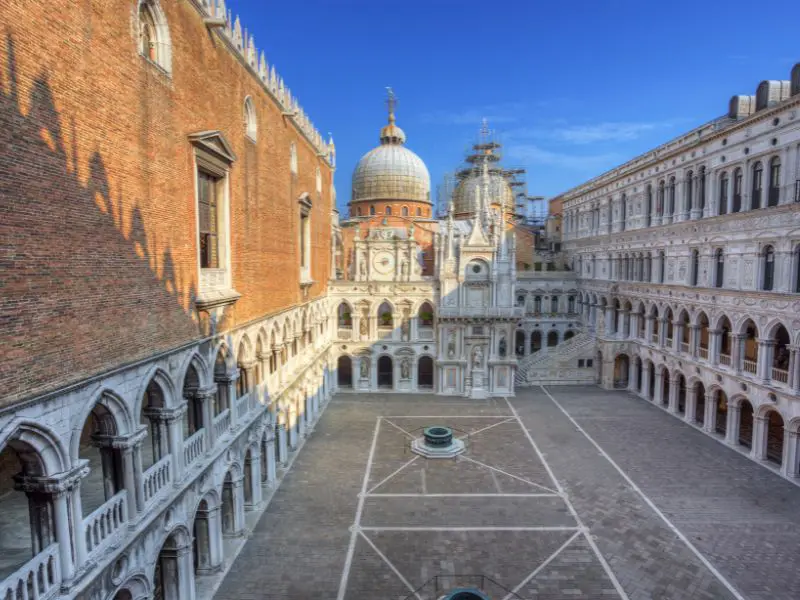
The Doge’s Palace in Venice is a must-visit for anyone interested in history, art, and architecture. If you’re planning to visit the Doge’s Palace in Venice, here’s what you need to know:
The Palace is open every day, usually from 9:00 am to 7:00 pm, with the last entry at 6:00 pm. But they have extended hours from May 12 to September 30, and on June 1, and August 14-15, when they’re open until 11:00 pm. Just remember, they’re closed on December 25 and January 1 and do not forget to check the official website for announcements.
You can visit the palace all year. But if you’d like to avoid the crowds, early April or September would be ideal. And weekdays are usually less crowded than weekends. It is always a good idea to book online early to avoid the long queues, especially during the peak season.
As for tours, there are quite a few options. You could go for a skip-the-line entrance ticket, a ticket with a guidebook, or a guided tour. Audio guides are available. There’s also a combined tour of Doge’s Palace and St. Mark’s Basilica, or an exclusive after-hours tour of both landmarks.
6. La Fenice
The 6th beautiful building on this list is special. It doesn’t have a fancy exterior, but it has one of the most amazing interiors you’ll ever see. It’s called La Fenice, which means “the phoenix” in Italian, and it’s one of the most beautiful theaters in the country.
Let me tell you the tragic but fascinating story of this beautiful building in Venice.
Imagine it’s 1790. A plot of land in Venice is cleared, making way for a grand vision — an opera house like no other. Architect Giannantonio Selva’s design is chosen from 29 plans, and in just 18 months, La Fenice is born in April 1792.
But the Phoenix wouldn’t be true to its name without a trial by fire. In 1836, a blaze engulfs the theater. Yet within a year, La Fenice rises from the ashes, restored to its former glory. Then in 1996, another fire, this time due to arson, reduces it to mere walls. But again, like a true phoenix, La Fenice is reborn and reopens its doors in November 2004.
Throughout its tumultuous history, La Fenice has been a stage for the extraordinary. It has premiered works of major bel canto era composers like Rossini, Bellini, Donizetti, and Verdi. Its halls have echoed with the talents of world-renowned artists and musicians such as Riccardo Chailly and Vladimir Temirkanov.
Today, La Fenice stands as a testament to resilience and artistry. It continues to enchant audiences with world-class performances, remaining one of Venice’s most cherished cultural institutions.
As for its architecture? La Fenice was originally designed in the Venetian neoclassical style. Despite the fires and reconstructions, this style was faithfully preserved. It is neoclassical style can still be seen from its facade, with sculptures that symbolize the performing arts.
Above the balcony, you’ll see comedy and tragedy masks, and sculptures of Melpomene, the muse of tragedy, and Terpsichore, the muse of dance. Inside, the opera house boasts a jaw-dropping interior that displays a late-Empire luxury of gilt decorations, plushy extravagance and stucco.
While La Fenice is composed of various sections such as the foyer, house, royal box, Sale Apollinee, Sale Dane, and more, the auditorium and its royal box are particularly striking. Their luxurious red and gold décor, ornate chandeliers, and plush velvet seats are nothing short of awe-inspiring.
Some folks even argue that it surpasses the historic opera houses in places like Vienna, Paris, or Milan. Regardless, when you visit, you can pick up an audio guide to learn more about its history and architecture.
La Fenice is nestled in the heart of Venice. It’s just a stone’s throw away from iconic landmarks like the Rialto Bridge and St. Mark’s Cathedral. You can reach La Fenice from the cathedral to La Fenice in just 5 minutes.
If you’re planning to visit, the theater welcomes visitors from Monday to Saturday, between 9:30 am and 6:00 pm. However, it’s always a good idea to double-check their official website for any changes or special events.
Tickets for guided tours? You can get them at the box office or even book them in advance online. Your ticket includes an audio guide available in different languages! Just remember to bring an ID to get one.
7. Palazzo Contarini del Bovolo
Just a short stroll from the La Fenice theater, you’ll discover Scala Contarini del Bovolo, arguably the most charming spiral staircase in all of Venice. This architectural gem is part of the quaint Palazzo Contarini del Bovolo, nestled in the city’s heart.
Added in 1499, this staircase spirals up a circular Byzantine-style tower, connecting the loggias of the main palace to a quaint residential courtyard below.
While you won’t catch a glimpse of the Venice Grand Canal from here due to its neighborhood location, the palazzo’s towering 28-meter high tower offers a panoramic view of Venice’s skyline. Notable sights like the tower in Saint Mark’s square and the dome of Basilica di Santa Maria Della Salute are visible from this vantage point.
Get an insightful tour of the beautiful buildings in Venice.
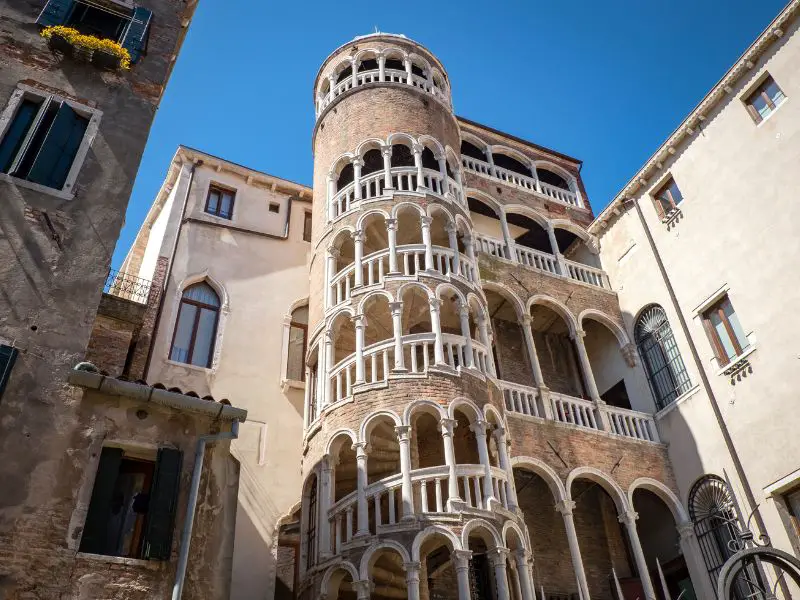
The Scala Contarini del Bovolo, which translates to “Staircase of the Snail”, is a perfect example of Venetian opulence and architectural ingenuity. This external multi-arch spiral staircase is the most distinctive feature of the Palazzo Contarini del Bovolo.
The staircase is set into a circular tower, reflecting a Byzantine style. It’s characterized by its ascending rows of round-headed arches, which are a unique feature not found elsewhere in Venice. The design creates a rhythmic and harmonious pattern that is pleasing to the eye.
The staircase also showcases elements of the Renaissance style. This is evident in its emphasis on symmetry, proportion, and geometry, which were key principles of Renaissance architecture.
The Scala Contarini del Bovolo does have elements of Gothic architecture, too.
If you look closely, you’ll see traces of this older style both on the outside and the inside of the building. On the side facing Saint Mark, there are visible portions of a lavish floral decoration, while the main façade overlooking Rio di San Luca still preserves the pristine late-Gothic appearance.
This blend of Gothic elements with Byzantine and Renaissance styles gives the Scala Contarini del Bovolo its unique and impressive architectural character.
The thing is, Palazzo Contarini del Bovolo where Scala Contarini del Bovolo is more than an architectural gem in Venice. The palace, which once served as a lodging house, played host to German astronomer Wilhelm Tempel. From the top of the tower, he discovered the comet C/1859 and the Merope Nebula of the Pleiades through his telescopic observations.
Fast forward to 1952, and American director Orson Welles chose this very location for his film adaptation of Shakespeare’s Othello, showcasing the elegant Scala Contarini del Bovolo in all its glory.
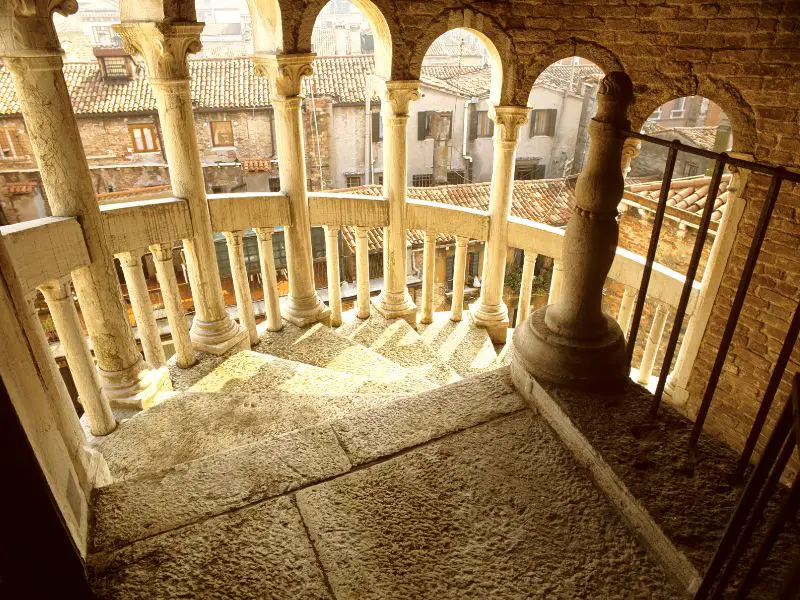
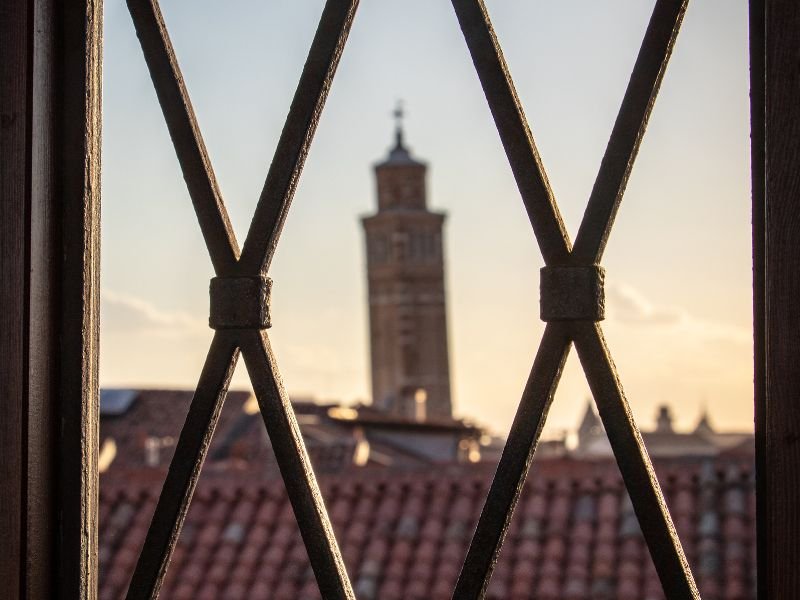
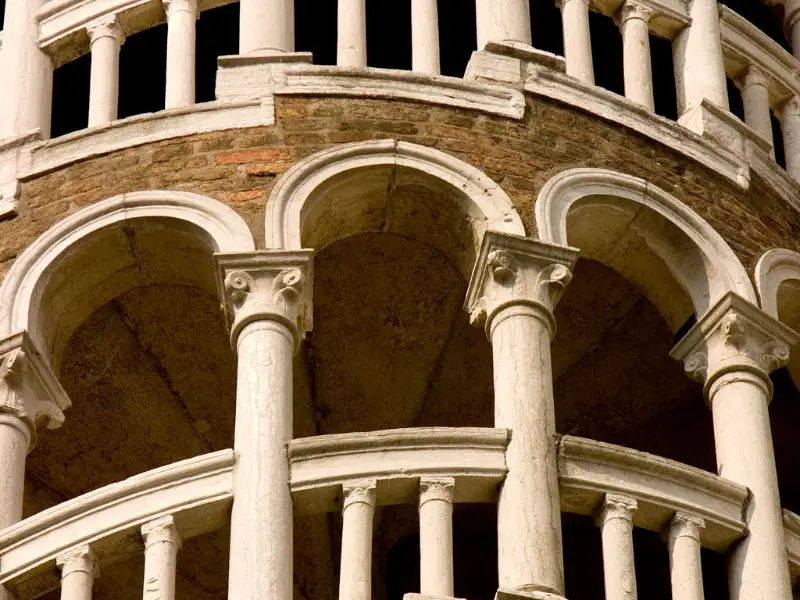
Do you want to visit?
The Scala Contarini del Bovolo is tucked away at San Marco 4299. Depending on where you’re starting from, you’ll find it in the San Marco district of Venice, nestled between the Canal Grande, Rio de San Salvador, Rio di San Luca and Rio Fuseri.
You can visit any day of the week. During winter (from October 30 until February 25), it’s open from 09:30 am to 5:30 pm, with last admission at 5:00 pm. In summer (from February 27), it’s open from 10:00 am to 6:00 pm, with last admission at 5:30 pm.
Tickets are available online and can be purchased from various platforms (get your skip-the-line tickets here). The ticket office closes 30 minutes before the monument does. What’s more, during normal opening hours, guided tours are offered in Italian, English and French. They also provide walking tours, shore excursions or tailor-made tours for a unique and exclusive experience.
If you’re into photography, I’d recommend going in the late afternoon before it closes at 6:00 pm. You’ll be able to capture the city of Venice bathed in the warm glow of the setting sun. Try to avoid visiting at noon as it can get quite crowded.
For updates and more information, please see the official website of Scala Contarini del Bevolo.
8. Procuratie
For ages, Saint Mark’s Square has stood as the core of Venice, a testament to the grandeur of Venetian architectural design. It houses not just the Saint Mark’s Basilica and Doge’s Palace, but also the Procuratie, another structure that adds to the city square’s picturesque scenery.
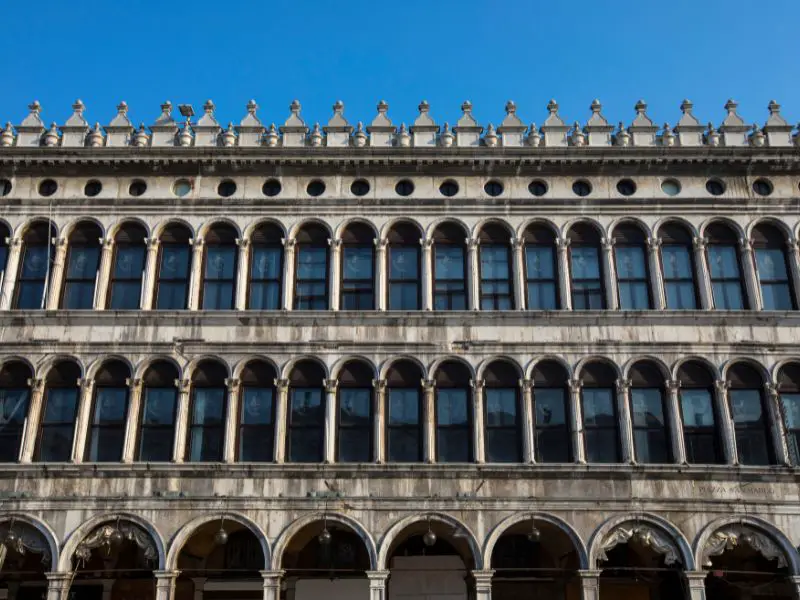
The Procuratie are three buildings that wrap around Saint Mark’s Square in Venice, Italy. They’re like the arms of the square, hugging it from three sides. Each one has its own name and style:
- The Procuratie Vecchie is on the north side. It’s an old building, finished in the early 16th century. It’s designed in the Early Renaissance style. Imagine walking around a building that’s been standing for over 500 years!
- The Procuratie Nuove is on the south side. This one was built to house the official residences of the procurators. It was completed between the late 16th and mid 17th centuries, and it’s designed in the High Renaissance style.
- The Procuratie Nuovissime, also known as the Napoleonic Wing, is the newest of the three. It was built during the French occupation in the early 19th century and is designed in the Neoclassical style.
Recently, the Procuratie Vecchie underwent a major restoration by David Chipperfield Architects Milan. They worked to preserve its historical architecture while adding new elements to make it more functional.
9. Santa Maria di Nazareth Church
The Venice Grand Canal is lined with stunning buildings, including two notable churches. The first is the Basilica di Santa Maria Della Salute, and the second is the Santa Maria di Nazareth Church.
You’ll find the Santa Maria di Nazareth Church conveniently located near the Venezia Santa Lucia railway station in Cannaregio, which is in the northern part of Venice.
The Santa Maria di Nazareth Church, also known as the Church of the Scalzi, is a Roman Catholic Carmelite church located in Venice that was built in the mid-17th century to the designs of Baldassarre Longhena. Interestingly, this Baroque church was founded by Barefoot Carmelites friars and finished in 1689.
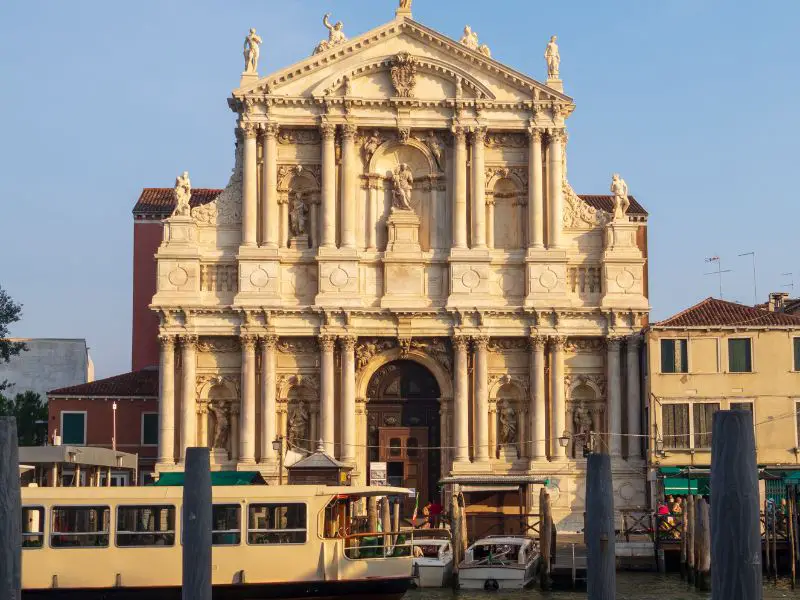
The Santa Maria di Nazareth Church may not be as large as the famous Saint Mark’s Basilica in Venice, but it’s a real treasure of late Venetian Baroque architecture that you shouldn’t miss. Step inside to discover one of Venice’s most underappreciated church interiors.
It’s a shame that many visitors overlook this beautiful church. Once you’re inside, you’ll find stunning religious artworks everywhere you look. The nave is flanked by altars that are rich in detail.
As soon as you step inside, you’ll surely notice a statue of St John of the Cross on your right, thought to be a creation of Falconi. Take a look around and you’ll spot the statues of Faith, Hope, and Charity by Tommaso Rues. Venture further in and you’ll find a statue of St Sebastian from 1669 with bronze bas-reliefs, also believed to be Falconi’s work.
Undoubtedly, the standout feature of this church is its vault. It was once home to a significant fresco by Giambattista Tiepolo depicting the Translation of the House of Loreto. Sadly, these frescoes were destroyed in an Austrian bombardment in 1915.
However, Ettore Tito stepped in to repair the damage with his paintings and frescoes. Today, remnants of Tiepolo’s work can be seen in the Gallerie dell’Accademia.
Another highlight of the Santa Maria di Nazareth Church is its high altar, a masterpiece crafted by Fra Giuseppe Pozzo. The tabernacle is surrounded by twisted columns and topped with a grand golden crown that sits above Mary’s statue — it’s quite a sight!
Swipe the image below to see more views of Santa Maria di Nazareth Church’s interiors:
Do you want to visit? The church welcomes visitors on both weekdays and holidays from 7:00 am until 1:00 pm and then reopens from 2:30 pm until 6:45 pm. Free to enter but do not forget to check the official website of the church for updates and more information.
10. Scuola Grande di San Marco
Last on our list of Venice’s top 10 beautiful buildings, but certainly not least, is the Scuola Grande di San Marco.
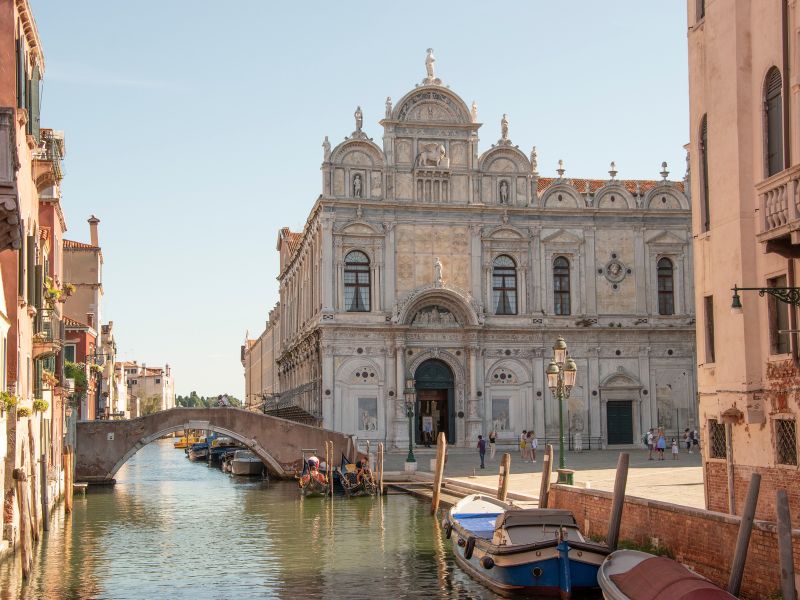
The Scuola Grande di San Marco has a rich history that dates back to 1260, when it was first built by the Confraternity of San Marco.
Originally located in what is now the area of the Papadopoli Gardens, it was granted an adjacent area by the Dominicans of Basilica dei Santi Giovanni e Paolo in 1437 for a new structure.
However, a large fire in 1485 led to its destruction.Undeterred by this setback, the members of the Scuola established a fund to rebuild it. Over the next two decades, under the new design by Pietro Lombardo, it was reconstructed. The façade was later completed by Mauro Codussi.
Between 2000 and 2005, conservation treatments were carried out on the façade, funded by Save Venice Inc., the Getty Grant Program, and other donors. Nowadays, it houses a hospital and is a sight to behold when sailing along Venice’s Fondamenta dei Mendicanti canal.
Yes, from the canal, it’s easy to see that the Scuola Grande di San Marco is a masterpiece of Renaissance architecture. Interestingly, while it features elements of Renaissance classicism, its numerous arches and niches add a Byzantine flavor, which is characteristic of many conservative Venetian styles.
Its façade is adorned with delicately decorated niches and pilasters, and statues made from white or polychrome marble that will surely marvel at.
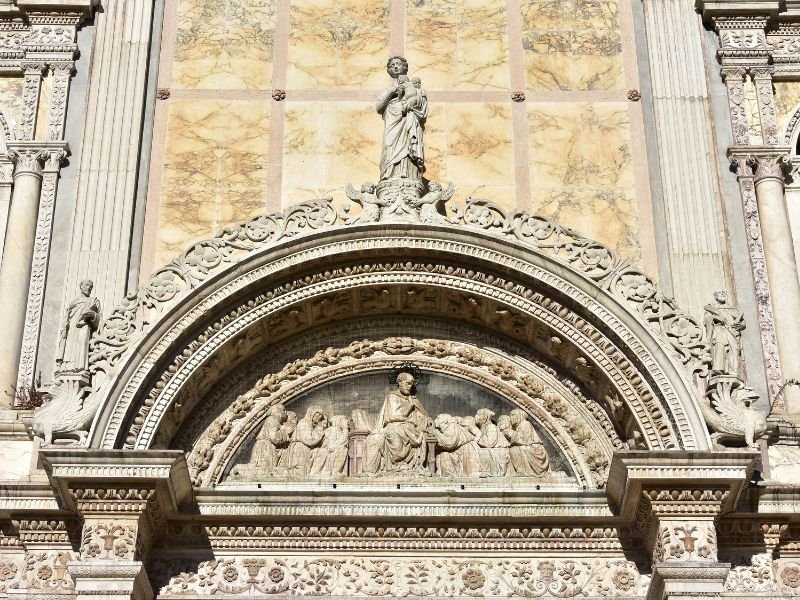
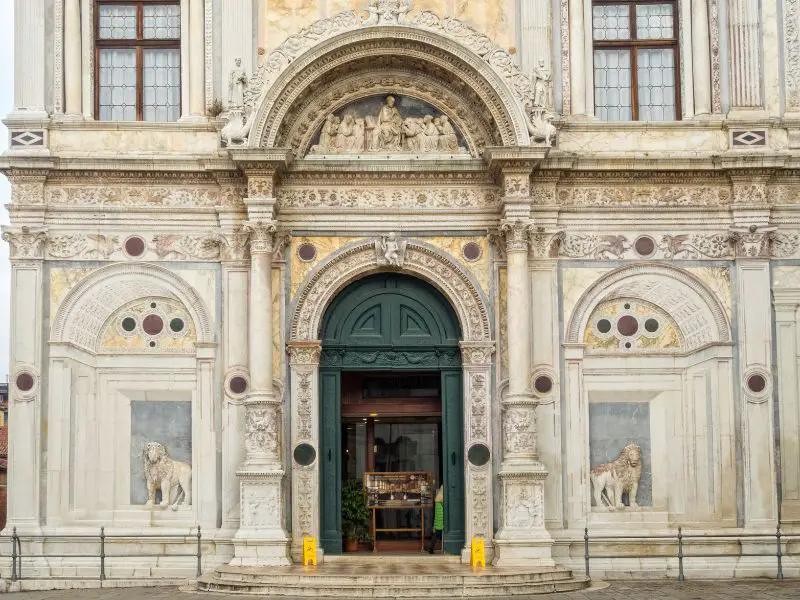

If you’re planning to visit the Scuola Grande di San Marco, it’s quite easy to get there. It’s located in Castello, right next to the famous Basilica dei Santi Giovanni e Paolo. The nearest vaporetto stop is Fondamente Nove. Just walk along the Fondamenta with the lagoon on your left until you reach a bridge. Turn right there onto Fondamenta dei Mendicanti and you’ll find it.
The Scuola is open from Tuesday to Saturday and every first Sunday of the month, from 10:00 am to 6:00 pm. For updates and more information, please check the official website of Scuola Grande di San Marco.
Map of the Most Beautiful Buildings in Venice (Walking Route)
And there you have it! Those are my top 10 picks for the most stunning architectural landmarks and destinations in Venice. I hope this guide has given you a good understanding of these Venetian attractions.
To help you navigate, here’s a map of Venice. It pinpoints the locations of all the beautiful buildings from our list. And if you’re planning to visit each one, there’s a walking route you can follow.
Prepare Your Venice Trip!
If Venice is your destination, here’s where you can score the best deals on hotels in the city. And if accommodation prices in Venice spike, don’t worry!
It has got you covered with options in nearby cities too. The hotel browser has a useful map feature that can guide you to the most conveniently located accommodations in Venice.
If you intend to visit the landmarks I’ve mentioned in this post, it’s crucial to be aware that Venice is grappling with the issue of over-tourism.
The attractions in the city can sometimes have long queues, particularly during peak season. One way to bypass this is to book ‘skip-the-line’ tickets in advance. Trust me, you won’t regret it!
See all the skip-the-line tickets, water taxi transfers, and tours in Venice.
Where to go after Venice?
While in Venice, don’t miss out on the numerous beautiful places that Italy has to offer nearby.
Northern Italy, where Venice is situated, boasts more historical sites and awe-inspiring destinations. From Venice, the underrated Verona and the Lake Garda, largest lake in Italy, are just a short 2-hour trip away.
For a more adventurous journey, head straight to the Italian Alps or the Dolomites from Venice!
The train ride to Bolzano, known as the Gateway to the Dolomites, takes only 3.5 hours. Trento, offering an experience that is a blend of nature and culture, is another worthwhile destination and it is just a 3-hour train ride from Venice.
From either Trento or Bolzano, you can embark on your journey to some of the best attractions in the Dolomites, including the stunning town of Cortina d’Ampezzo.
You might also want to see more places in Northern Italy.
- Lake Como — Visit some of the most idyllic villas in Italy!
- Milan — See the unmissable Milan Cathedral and learn so many things about Leonardo da Vinci!
- Bergamo — For a mix of history and scenic beauty.
- Florence — Behold at its stunning church and famous Renaissance artworks.
- Rome — Timeless beauty awaits you here.
- Cinque Terre — The most scenic coastal villages in northern Italy!
Save it on Pinterest.
